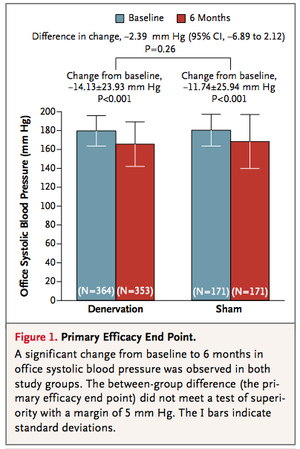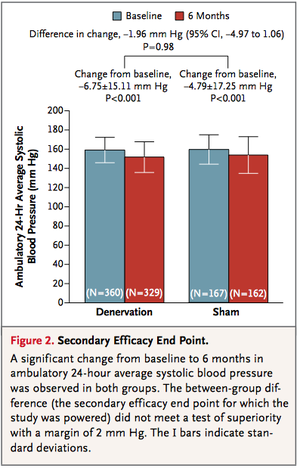Chance News 99
Quotations
"[Penn psychologist Philip Tetlock] found that, though a given expert might foretell one extreme event, doing so consistently was next to impossible. …. Tetlock found that experts who claimed to be more certain were more in demand in the media, even though they were less likely to be correct. A study of financial advisers found that those who claimed they knew what stocks were going to do were seen as more credible than those who expressed uncertainty …."
The New Yorker, April 7, 2014
See a review of Tetlock's 2005 book Expert Political Judgment: How Good Is It? How Can We Know? in Chance News 10.
Submitted by Margaret Cibes
Forsooth
Here is a genuine Forsooth:
- "...a [Brazilian] government research agency said recently that 65% of respondents to a national survey agreed that women showing too much of their bodies deserve to be attacked.
- "On Friday, the Institute for Applied Economic Research said it was mistaken and that the true number was actually 26%."
Submitted by Paul Alper
More details on the corrections can be found here. We read that the finding "was originally represented by a graphic that showed that 42.7 percent of 3,810 respondents agreed with [the statement], 22.4 percent agreed partially, 8.4 percent partially disagreed and 24 percent totally disagreed. The true values, according to IPEA, should have been 13.2 percent strongly agreed with the statement, 12.8 percent partially agreed, 11.6 partially disagreed, 58.4 percent totally disagreed and 3.4 percent remained neutral."
MedPage TODAY said that “CDC says rates of teen pregnancy have been on the decline over the past 20 years, but that more than one in four teens ages 15 to 17 are still having babies.” If you think that that "one in four teens..." sounds unbelievable, you are correct. The actual CDS statement was “More than 1 in 4 teens who gave birth [emphasis added] were ages 15 to 17....”
A recent article by Stella Dudzic in Significance magazine deals with an analogous situation and mentions developing a curriculum to help people “look at information like this which they encounter in the news, on the internet or while reading a book or report and think about whether it is likely to be true before accepting it.”
Submitted by Emil M Friedman
From the Forsooth! column of StatsLife at The Royal Statistical Society website:
- "The risk of developing cancer falls by 10% for every 10g of fibre eaten, according to a report by Cancer UK." (Forsooth! Feb 2014)
- "The 2.45 at Doncaster: number one, 'Minella Definitely’; that’s a probable certainty.” (Jan 2014)
- "The UK mean income in 2011 was £27,000, but the median income was £21,500. This means that 50 per cent of people earned less than £27,000." (Nov 2013)
- "In a computer simulation of human behaviour in the layouts exited most swiftly by ants ..., evacuation times were reduced by up to 160 per cent." (Nov 2013)
- "A Chi-squared test was applied to these data, using the formula [chi-squared formula shown].
"Chi-squared was calculated as 18 995 and was significant at both the 95% and 99% significance levels." (Nov 2013)
- "The forecasters were predicting only a 10% or 20% chance of rain in Dunedin yesterday, but it turned out to be 100%." (Apr 2013)
- "A fifth of over-30s have never swum in the sea, a tenth have never strolled along a Mediterranean beach and 13 per cent have never been abroad at all." (Feb 2013)
Submitted by Margaret Cibes
Renal denervation
Setback for high blood pressure treatment
by Denise Grady, New York Times, 29 March 2014
According to the article, "In the United States, 67 million people have high blood pressure, and it resists treatment [by drugs] in about 10 percent of them."
Thus, the interest in
The treatment, called renal denervation, [which] involves threading a tube through blood vessels into the renal arteries, [and] then zapping them with radio-frequency energy to kill nerve endings.
The procedure was thought to be a lifesaver for people whose high blood pressure could not be lowered even with multiple drugs. Uncontrolled hypertension increases the risk of strokes, heart attacks and other problems.
Previous “case reports and studies had found astounding drops in blood pressure after the [renal denervation] treatment — as much as 30 millimeters of mercury in systolic pressure, the top number in a blood pressure reading.” Therefore, to the surprise of many, renal denervation failed in a large, rigorous study.
Unlike earlier, unblinded studies, this so-called SYMPLICITY HTN-3 study was
a prospective, single-blind, randomized, sham-controlled trial. Patients with severe resistant hypertension were randomly assigned in a 2:1 ratio to undergo renal denervation or a sham procedure.
The primary efficacy end point was the change in office systolic blood pressure at 6 months; a secondary efficacy end point was the change in mean 24-hour ambulatory systolic blood pressure.
From the figures below, it can be seen that the treatment (renal denervation) and the control (sham treatment) are virtually identical for the primary and secondary efficacy, respectively. That is, for primary efficacy, the treatment failed to beat the control by at least 5 mm HG and for secondary efficacy, the treatment failed to beat the control by at least 2 mm Hg.
Discussion
1. Franz H. Messerli wrote an editorial in the NEJM entitled “Renal Denervation for Resistant Hypertension?” in which he questioned the enthusiasm for the procedure. It has not been approved in the United States but according to Grady,”it has been approved in more than 80 countries and performed on thousands of patients.” She quotes Messerli as saying
You have to perhaps congratulate the Food and Drug Administration that they were not as eager to approve this procedure based on the little evidence there was, as opposed to the Europeans and the Australians.
It [SYMPLICITY HTN-3] is absolutely a landmark study. I hope it will have an impact and will override some of the zeal of the European investigators.
2. As indicated above, the (15) authors of the study regard “clinical (i.e., practical) significance” to be a primary superiority of at least 5 mm Hg or a secondary superiority of at least 2 mm Hg of the treatment over the control. Neither was achieved but with the help of any convenient statistics software, use the numbers in Figure 1 and Figure 2 to show that “statistical” significance was also not achieved in either case for the respective differences between treatment and control.
3. The study also looked at subgroups such as race, gender, age, etc.
Although the differences between groups in some subgroups were nominally significant, the absolute magnitude of the differences was small (<10 mm Hg), and the differences were not significant with the use of a superiority margin of 5 mm Hg or after adjustment for multiple comparisons.
Which “significances” are being discussed here?
4. Point out the similarities of a sham treatment to the use of a placebo when testing drugs. Point out the differences between a sham treatment and a placebo.
Submitted by Paul Alper
Statistics goes to the movies
While the 2012 book Math Goes to the Movies focuses on mathematics, there are several recent articles on statistics in the movies, all written by Michael A. Lewis (Hunter College School of Social Work).
"The search for 'Divergents' and measurement error", Significance, April 7, 2014
"The Silver Linings Chi-Square Playbook", Significance, February 12, 2013
"Probability and Game Theory in The Hunger Games", Wired Social Blogs/Social Dimension, April 10, 2012
"Mathematics and The Hunger Games", Journal of Humanistic Mathematics, July 2012
Submitted by Margaret Cibes
Colicky babies and probiotics
Baby colic (also known as infantile colic) is defined as episodes of crying for more than three hours a day for more than three days a week for three weeks in an otherwise healthy child between the ages of two weeks and four months.
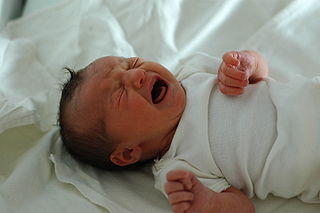
Colicky babies have been around ever since the human race emerged. Probiotics, a linguistic hybrid, almost as long:
The term probiotic is currently used to name ingested microorganisms associated with beneficial effects to humans and animals. Introduction of the concept is generally attributed to Nobel Prize recipient Eli Metchnikoff, who in 1907 suggested that "the dependence of the intestinal microbes on the food makes it possible to adopt measures to modify the flora in our bodies and to replace the harmful microbes by useful microbes."
But do the "live micro-organisms which, when administered in adequate amounts, confer a health benefit on the host"? Many current-day consumers of various versions of fermented milk products certainly believe this to be true. As has been pointed out many times, adults may succumb to the placebo effect; but babies do not lie so it is only “natural” to do a randomized control trial to see if probiatics can reduce suffering in colicky babies. Naturally, newborn babies can’t ingest items such as yogurt or kafir. Therefore, the probiotic used for babies is lactobacillus reuteri dsm 17938 administered via a dropper:
Susan Perry observes
Over the years, parents — and pediatricians — have tried all sorts of remedies to quiet colicky infants. Probiotics is among the latest of these. It’s based on the supposition that promoting microbial diversity in the gut will reduce the formation of gas and intestinal inflammation.
For the current study, a team of Australian researchers recruited 167 breastfed and formula-fed infants (all less than 3 months old) with colic. Each baby met the criteria of a commonly used diagnosis of infant colic: An infant who cries or fusses for three hours or more daily, three or more times a week, and for at least three weeks.
About half of the babies were randomized to receive daily supplemental drops of the probiotic L. reuteri for one month; the other half received a placebo. The study was “doubled-blinded” so that neither the parents nor the researchers knew which babies were in which group.The parents were also instructed to keep a daily diary of their baby’s behavior, including such measurements as how long the baby fussed, cried and slept. Other outcomes were also followed and measured, including the mothers’ mental health and the families’ ability to function and have a “quality of life.”
From the Australian study by Sung et al we obtain the following graphs and associated conclusions:

Conclusions: L reuteri DSM 17938 did not benefit a community sample of breastfed infants and formula fed infants with colic. These findings differ from previous smaller trials of selected populations and do not support a general recommendation for the use of probiotics to treat colic in infants.
There is a short video of Sung explaining the study. Below is the so-called “Baby Day Diary” taken from the video illustrating how data is recorded.
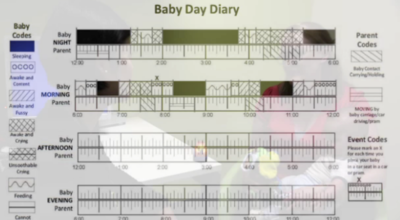
Discussion
1. What is misleading about the abscissa in the above Fig 2?
2. As is typical in the medical field, unanimity is hard to come by. The above study by Sung for treating babies who already had colic, appeared in April, 2014 in the BMJ. In January, 2014 a paper by Indrio, et al appeared in JAMA which concluded that on the basis of its randomized clinical trial:
Prophylactic use of L reuteri DSM 17938 during the first 3 months of life reduced the onset of functional gastrointestinal disorders and reduced private and public costs for the management of this condition.
The tables below indicate that statistical significance is obtained with respect to preventing colic at one month and at three months. Assume there were 238 in the treatment arm and 230 in the placebo arm; use whatever statistics package is available, and see what p-values you obtain regarding the difference (probiotic minus placebo) in colic minutes per day utilizing the numbers in Table 2 and Table 3.
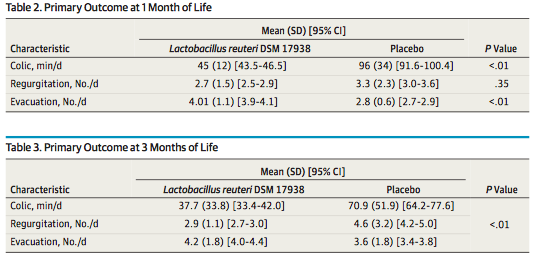
3. In addition to the p-values in Table 2 and Table 3, Table 4 has lots of p-values, most of which are less than the magical .05. If a p-value less than .05 is noteworthy, why is this collection of p-values less impressive?
4. Note that if you were to do a search for the probiotic used in both of the studies discussed,“lactobacillus reuteri dsm 17938,” which is made by a Swedish company, BioGaia, you will find many positive hits. On the Wikipedia BioGaia page itself we find this cautionary note: "The neutrality of this article is disputed. Relevant discussion may be found on the talk page. Please do not remove this message until the dispute is resolved. (March, 2013)"
5. There is an accompanying editorial to Bennett to Sung’s article. Bennett says
Infant colic is a challenging problem for many parents, but the cause and effective treatment remain elusive. As its name suggests, colic was thought to arise in the gastrointestinal tract, but after centuries of this supposition we still do not know if this is true. A host of home remedies and drug treatments have circulated over the years, ranging from whisky, to acid suppression, to anticholinergic agents, and onwards to medicine’s most recent “hammer looking for a nail,” probiotics.
He poses the question
“Should we be treating infant colic at all?” A great deal of accumulated clinical experience tells us that children with colic incur no serious long term effects from the disorder, and that symptoms abate with time. The potential harm associated with diagnostic testing and treatment of infants
is likely to surpass the harm from colic itself.
Bennett concludes with sage advice:
As the old adage goes, “babies cry.” Parents and their babies may be better served if we devote more resources to studying the interventions recommended long before the discovery of probiotics: reassurance, family social support, and the tincture of time.
Look up the evocative phrase “the tincture of time” to determine its relevance to colicky babies.
6. A sample of size one is not impressive statistically. Nonetheless, be sure to ask your parents whether or not you were a “fussy” baby. If you weren’t, ask them what they did to prevent colic. If you were, ask them what they did to treat you.
Submitted by Paul Alper
